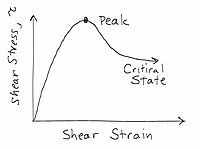
Photo from wikipedia
To evaluate the stability of a slope subjected to pile driving in nonhomogeneous and anisotropic soils, an upper-bound limit analysis method is employed in this paper. A 3D rotational failure… Click to show full abstract
To evaluate the stability of a slope subjected to pile driving in nonhomogeneous and anisotropic soils, an upper-bound limit analysis method is employed in this paper. A 3D rotational failure mechanism for soil slope is extended to account for different failure patterns (i.e., toe failure and base failure). In order to avoid missing the global minimum, an efficient optimization method is simultaneously employed to find the least upper bound to the factor of safety ( ). The effectiveness and accuracy of the proposed method is well demonstrated by comparing the results obtained from the proposed approach with the solutions from published literatures. The effects of key designing parameters are presented and discussed. The optimal pile location and the three-dimensional effect of the slope are discussed. In addition, these results highlight that the adverse effects of pile driving on slope stability should be highly concerned during the design of geotechnical infrastructures, rather than emphasizing the reinforcement effect of a pile only.
Journal Title: Advances in Civil Engineering
Year Published: 2020
Link to full text (if available)
Share on Social Media: Sign Up to like & get
recommendations!